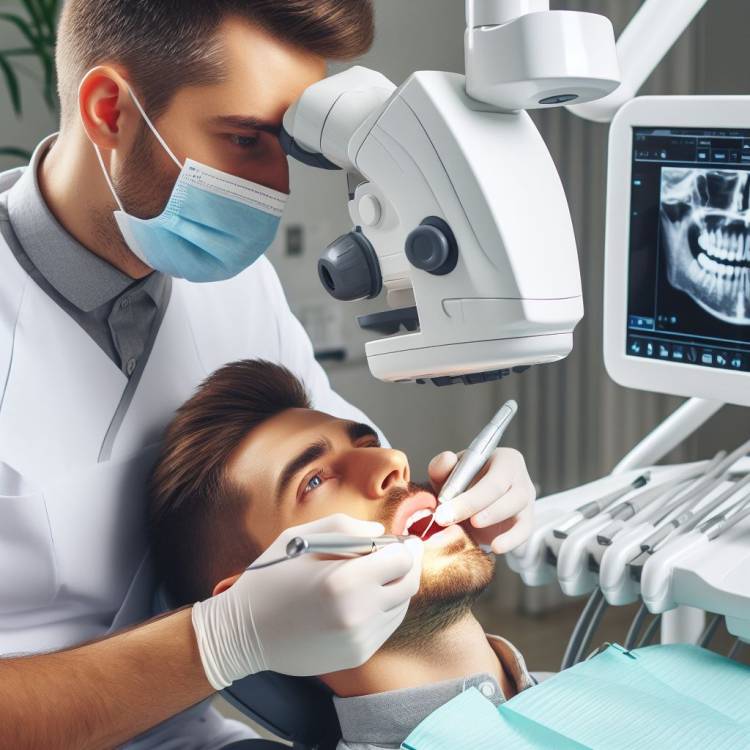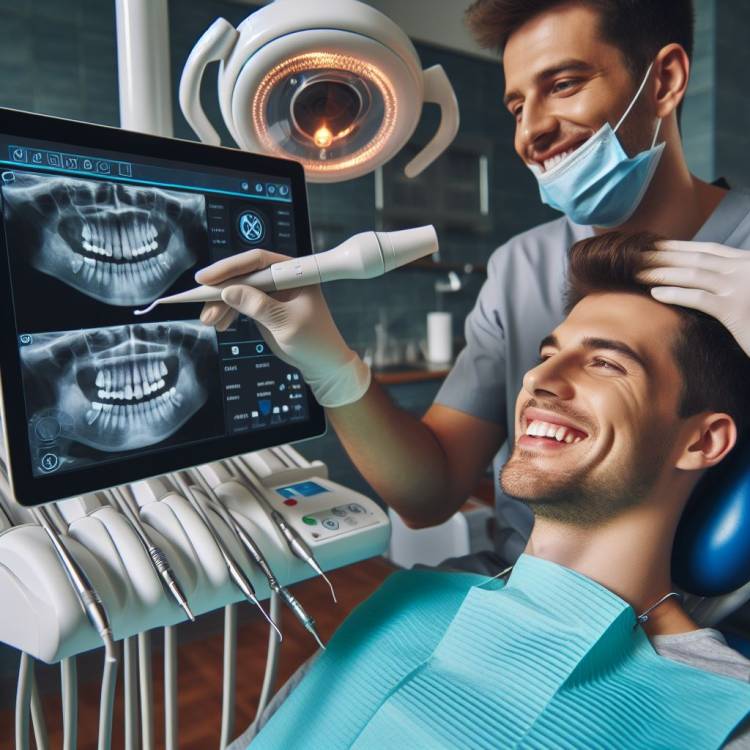Welcome to an in-depth exploration of advanced treatments for severe gum disease. This article dissects a detailed case study, drawing from the insights of Li et al.’s recent report in the World Journal of Clinical Cases (2022). Through this case, they unravel the methodology and intricate treatment plans employed to overcome significant oral health challenges.
From non-surgical periodontal interventions to innovative orthodontic and prosthodontic solutions, they navigate through each stage of treatment. Join us as they shed light on the amalgamation of cutting-edge techniques that contributed to the successful restoration of oral health in the face of severe gum disease.

Explaining The Case Study
A 47-year-old woman, previously healthy, came to the hospital with concerns about loose teeth and difficulties chewing. She had been experiencing long-term issues with tooth loss, mild bad breath, and occasional bleeding during brushing.
Despite no significant medical or family history, a physical examination revealed poor oral hygiene with a considerable amount of dental calculus and noticeable plaque. Her gums were tender and swollen, with specific teeth showing distinct inclinations and extreme looseness.
Upon examination, they found that 83% of her teeth exhibited some level of mobility, and over 50% had a probing depth (distance between the gum and tooth) greater than 4 mm with bleeding. Based on established classifications, she was diagnosed with advanced periodontitis, a skeletal malocclusion, and moderate crowded malocclusion.
A collaborative team of periodontists, orthodontists, and a prosthodontist devised a treatment plan. Considering the severity of her periodontal issues and dental calculus, they began with supragingival ultrasonic scaling to establish a baseline for further examination a week later.
This case underscores the complex interplay of periodontal and orthodontic issues, necessitating a coordinated approach for comprehensive care.
Methods
Oral Hygiene (Plaque Assessment):
They checked how clean the teeth and gums were by looking at them and using a tool to measure plaque near the gum line.
Florida Probe:
They used a high-tech system called the Florida probe. It’s like a computerized tool that measures gum health and creates digital records of each treatment session, helping us track progress.
Periodontal Pocket Depth:
They used a small tool to measure how deep the space is between the teeth and gums. This helps us understand the health of different areas around each tooth.
Tooth Mobility Assessment:
They gently moved the teeth to see how much they could wiggle. This helps us assess if there’s any looseness, and they graded it based on the degree of movement.
Bleeding on Probing:
They checked for bleeding by inserting a small tool into the space between the teeth and gums. If there was bleeding, it indicated potential issues with gum health.
X-ray Evaluation:
They used special X-ray images (panoramic and apical radiographs) to see the hard tissues, especially the bone that holds the teeth. This helps us visualize the health of the supporting structures.
In simpler terms, these methods allowed us to examine how clean the mouth was, use advanced technology to monitor and record progress, measure the depth of spaces around the teeth, check for any looseness of the teeth, see if there was bleeding indicating potential issues, and use X-rays to get a detailed look at the supporting bone structures.
These assessments help us understand and treat severe gum disease more effectively.

Treatment
Initial Assessment:
At the outset, the patient presented with significant oral health challenges, including poor oral hygiene, a substantial accumulation of dental calculus, and noticeable plaque retention. Specifically, tooth No. 21 exhibited a distinct labial inclination, while teeth Nos. 31 and 41 were notably loose.
Treatment Goals:
The primary objective of the treatment plan was multifaceted. It aimed to enhance the overall periodontal health, instil effective oral hygiene practices, and address aesthetic concerns and occlusion issues that the patient was experiencing.
Comprehensive Treatment Plan:
Non-Surgical Periodontal Therapy:
- Mechanical Plaque Removal: The initial phase involved the mechanical removal of bacterial plaque through nonsurgical treatment. This encompassed supra- and subgingival scaling and root debridement using a periodontal endoscope.
- Tooth Extraction: During the second visit, teeth Nos. 22, 31, and 41 were extracted. The goal was to eliminate compromised teeth to support overall oral health.
- Periodontal Endoscope: The use of a periodontal endoscope during scaling and root planning ensured thorough calculus removal in sites with pockets ≥ 5 mm.
- Plaque Control and Monitoring: Following active therapy, professional plaque control sessions were conducted, reinforcing oral hygiene practices through monthly checks and the use of plaque disclosing agents. After 12 weeks, periodontal inflammation was significantly reduced.
Orthodontic Treatment:
- Risk Assessment: Before initiating orthodontic treatment, a detailed examination and risk assessment were carried out using a Florida probe.
- Periodontal Pocket Reduction: Significant reduction in periodontal pockets was observed during probing, prompting the initiation of orthodontic treatment.
- Ongoing Monitoring: The patient underwent periodontal maintenance every 3 months throughout orthodontic therapy, ensuring continuous assessment and recording of any changes in her condition.
- Positive Outcomes: Positive therapeutic effects, a low risk assessment level, and overall improvements in pocket depth were achieved.
Prosthodontic Treatment:
Consultation and Evaluation: After non-surgical periodontal and orthodontic interventions, the patient was referred for a prosthodontic treatment plan considering compromised periodontal health and tooth mobility issues.
Maryland Bridge: A Maryland bridge was chosen to restore missing teeth on one side, while dental splints were employed to stabilize loose teeth on the other side.
Periodontal Maintenance and Follow-Up:
- Regular Follow-Ups: Post-prosthodontic treatment, the patient underwent follow-up visits every 3 months, including intraoral images and periodontal examination with a Florida probe.
- Stable Periodontal Condition: The results indicated a stable periodontal condition and effective plaque control.
- Radiographic Assessment: Six months later, radiographic data revealed a continuous stable periodontal condition with no additional alveolar bone loss.
In summary, the detailed and comprehensive treatment plan involved a phased approach, addressing initial oral health issues through non-surgical periodontal therapy, followed by orthodontic intervention, and ultimately prosthodontic solutions. The continuous monitoring and follow-up ensured the stability of the improved periodontal condition, reflecting the success of the integrated treatment strategy in managing severe gum disease.
Results
In this case study, a comprehensive approach was employed to treat severe gum disease over 38 months, integrating periodontal, orthodontic, and prosthodontic treatments. Initially, non-surgical periodontal therapy involving advanced scaling techniques and real-time imaging with a periodontal endoscope significantly improved the patient’s gum health.
After 19 months of orthodontic treatment, focusing on realigning teeth and correcting occlusal issues, excellent outcomes were achieved. It is emphasized that controlling periodontal inflammation is crucial for successful orthodontic treatment.
The prosthodontic phase, undertaken after assessing stable periodontal conditions, utilized a Maryland bridge to restore missing teeth. This approach, along with bonded dentures, provided favorable long-term results, demonstrating a cumulative denture survival rate of 76.2% over ten years.
In summary, the multidisciplinary approach, including meticulous plaque control, led to remarkable improvements in aesthetics and occlusion, emphasizing the effectiveness of non-surgical periodontal treatment in achieving satisfying therapeutic outcomes even in severe periodontitis cases.
My Final Thoughts
In my final thoughts on the report, it’s clear that treating advanced gum disease requires a team approach involving different dental specialties like braces, tooth replacement, and root canal treatment. This case report gives us new ideas on how a step-by-step, non-surgical method can be effective in dealing with serious gum problems. It shows that by carefully planning and following a systematic treatment, they can significantly improve the outcome for patients with advanced gum disease.
FAQs
- What methods were used to assess the patient’s oral health initially?
The patient’s oral health was assessed through visual inspection, probing, and utilizing the Florida probe, a computerized system for periodontal assessment. X-ray evaluations were also employed. - What did the initial oral examination reveal about the patient’s condition?
The initial examination showed poor oral hygiene, significant dental calculus, and issues such as tooth inclinations and mobility. Gingiva tissues appeared tender and edematous. - What was the goal of the non-surgical periodontal therapy, and how was it conducted?
The goal was to improve periodontal health and control inflammation. The therapy involved supra- and subgingival scaling, as well as root debridement using a periodontal endoscope for a more detailed cleaning. - How was the patient’s periodontal condition monitored after the initial treatment?
Periodic checks were conducted, including the use of plaque disclosing agents, professional plaque control sessions, and continuous monitoring of periodontal parameters with the Florida probe. - What role did orthodontic treatment play in the patient’s overall care?
Orthodontic treatment aimed at improving tooth alignment, eliminating occlusal trauma, and restoring stability. It was initiated after achieving a stable periodontal condition. - How long did the orthodontic treatment last, and what were the treatment effects?
The orthodontic treatment lasted 19 months and provided excellent effects in terms of realigning teeth and dispersing occlusal force for healthier periodontal tissues. - What factors were considered in the prosthodontic treatment plan, and what options were chosen?
Prosthodontic treatment options were considered based on stable periodontal conditions. A Maryland bridge was chosen for its minimal tooth preparation, while dental splints were used for loose teeth. - How were the treatment results assessed over time?
Continuous follow-up visits every 3 months included intraoral images, periodontal examinations, and radiographic assessments. The results indicated stable periodontal conditions and good plaque control. - What insights does the case study provide about non-surgical periodontal treatment in severe cases?
The case study highlights the effectiveness of non-surgical periodontal treatment, showing significant improvements in overall periodontal condition and therapeutic outcomes. - What does the multidisciplinary approach in this case suggest for treating advanced periodontitis?
The multidisciplinary approach, involving orthodontics, prosthodontics, and endodontics, is crucial for successful outcomes in advanced periodontitis cases, emphasizing the need for a comprehensive and coordinated treatment strategy.
PRISTINE SMILES DENTAL CARE JUHU
1, Jayanti Niwas, opp. Vaishali Hotel, near Iskcon Temple, Jukarwadi, Juhu, Mumbai, Maharashtra 400049
